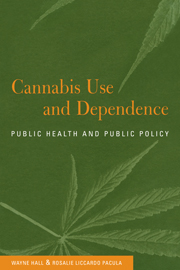Book contents
- Frontmatter
- Dedication
- Contents
- List of figures and tables
- Foreword
- Acknowledgements
- 1 Introduction
- Section 1 Cannabis the drug and how it is used
- Section 2 The health effects of cannabis
- Section 3 The psychological effects of chronic cannabis use
- Section 4 Effects on adolescent development
- Section 5 Harms and benefits of cannabis use
- Section 6 The effectiveness and costs of cannabis prohibition
- Section 7 Policy alternatives
- Appendix 1
- Appendix 2
- References
- Index
Appendix 1
Published online by Cambridge University Press: 05 July 2016
- Frontmatter
- Dedication
- Contents
- List of figures and tables
- Foreword
- Acknowledgements
- 1 Introduction
- Section 1 Cannabis the drug and how it is used
- Section 2 The health effects of cannabis
- Section 3 The psychological effects of chronic cannabis use
- Section 4 Effects on adolescent development
- Section 5 Harms and benefits of cannabis use
- Section 6 The effectiveness and costs of cannabis prohibition
- Section 7 Policy alternatives
- Appendix 1
- Appendix 2
- References
- Index
Summary
The evidence reviewed in Chapter 13 shows that THC is moderately effective in treating nausea and vomiting and appetite loss and it may be useful in treating acute and chronic pain. Advocates for the medical use of cannabis argue that patients should be allowed to smoke cannabis to relieve these symptoms because smoked marijuana is superior to oral THC (Grinspoon and Bakalar, 1993).
We review various ‘medical marijuana initiatives’ that have been proposed to achieve this goal in this appendix (rather than in the book proper) for the following reasons. First, if cannabis was legalised (or its use was decriminalised) then anyone who wanted to could use it for therapeutic purposes (Grinspoon and Bakalar, 1993). The debate about whether cannabis use should or should not be legalised is therefore more fundamental. Second, cannabis is unlikely to be legalised simply because it has medical uses. Legalisation requires a much stronger political justification. Third, some proponents of ‘medical marijuana’ have arguably used citizen-initiated referenda as a way to legalise cannabis by stealth and to embarrass intransigent defenders of prohibition who refuse to concede that cannabis may have any therapeutic uses. There are, however, ways in which patients could be given access to cannabis or cannabinoids for medical use without removing the prohibition on recreational cannabis use. We describe these and their limitations in this appendix.
Why can't patients use pharmaceutical cannabinoids?
If cannabis or cannabinoids are shown to have medical uses it would seem a simple matter of registering them for medical use. Dronabinol (THC) and nabilone have been registered for medical use as anti-emetics and appetite stimulants in the USA and the UK respectively. They have not been widely used in clinical practice because patients find it difficult to titrate doses of these drugs (Institute of Medicine, 1999).
Recent work on the biology of the cannabinoid system (Iversen, 2000) raises the prospects of new therapeutic cannabinoids being developed but pharmaceutical companies face substantial disincentives to develop and market new cannabinoids (Institute of Medicine, 1999). First, the research and development costs of cannabinoids are similar to neuropharmaceuticals which are costly to develop and register. Second, only synthetic cannabinoids can be patented, naturally occurring ones like THC cannot.
- Type
- Chapter
- Information
- Cannabis Use and DependencePublic Health and Public Policy, pp. 227 - 235Publisher: Cambridge University PressPrint publication year: 2002



